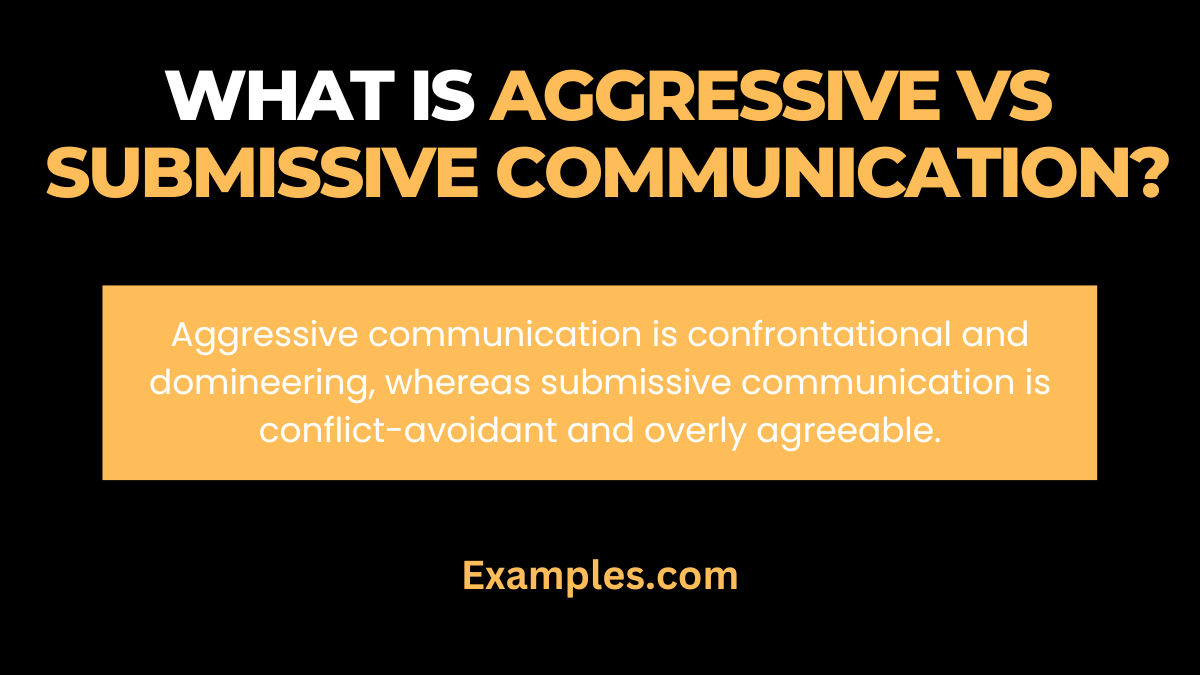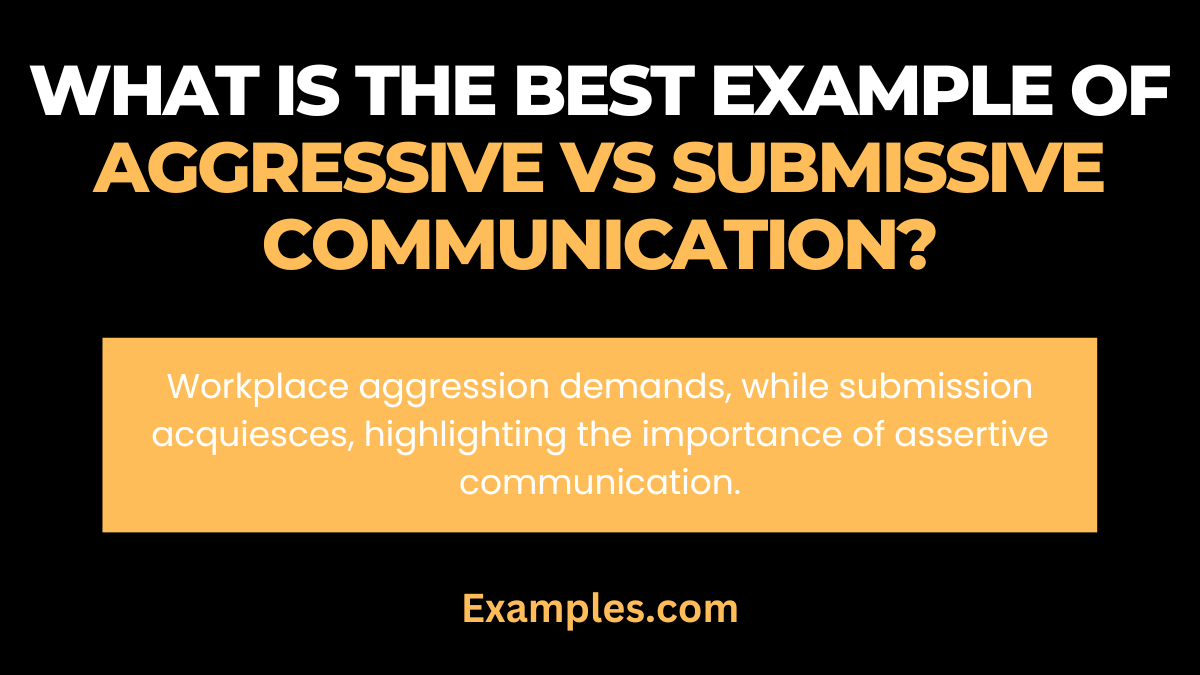Aggressive vs Submissive Communication – 19+ Examples
Aggressive vs submissive communication represents two ends of the communication spectrum. Aggressive communication often involves verbal attacks, intimidation tactics, and overbearing behavior, characterized by a lack of regard for others’ feelings. In contrast, submissive communication tends to be overly passive, involving yielding and acquiescing to others, often at the expense of one’s own needs. Understanding the dynamics of these communication styles is crucial for effective interpersonal interactions, particularly in achieving a balance that respects both self and others.
What is Aggressive vs Submissive Communication?

Aggressive vs submissive communication contrasts two distinct ways individuals express themselves. Aggressive communication is often confrontational and domineering, marked by shouting, demanding, and blaming. On the other hand, submissive communication is characterized by avoidance of conflict, reluctance to express opinions, and a tendency to agree with others even when disagreeing. Recognizing these styles is important in personal and professional settings to promote healthier and more balanced communication approaches.
What is the Best Example of Aggressive vs Submissive Communication?

A quintessential example of aggressive vs submissive communication can be observed in a workplace scenario. An aggressive communicator might demand compliance with their ideas, using phrases like, “Do it my way, or else!” contrasting with a submissive communicator who might say, “Whatever you think is best, I’ll go along with it,” even if they have valid concerns. These examples highlight the need for assertive communication, which combines clarity and respect, avoiding the pitfalls of both aggression and submission.
Difference Between Aggressive and Submissive Communication

Aggressive and submissive communication styles stand in stark contrast to each other, each with distinct characteristics that impact interpersonal interactions in varied ways.
| Aspect | Aggressive Communication | Submissive Communication |
|---|---|---|
| Approach to Disagreement | Often escalates disagreements with assertive responses. | Tends to avoid or yield in disagreements. |
| Leadership Style | Dominating, often making decisions without consultation. | Reluctant to lead, prefers to follow others’ decisions. |
| Response to Stress | Reacts impulsively, often with anger or frustration. | Withdraws or becomes passive under stress. |
| Communication in Team Settings | Tends to dominate discussions, overshadowing others. | Rarely contributes, allowing others to lead. |
| Attitude Towards Others | Can be dismissive or belittling towards others. | Often overly accommodating or deferential. |
| Handling of Mistakes | Blames others, avoids taking personal responsibility. | Readily accepts blame, even when not at fault. |
| Expression of Personal Views | Forcefully expresses opinions, disregarding opposition. | Hesitates to express personal views or opinions. |
| Goal in Communication | Aims to assert dominance and control over the situation. | Seeks to avoid conflict and maintain peace at all costs. |
10 Examples of Aggressive Communication
Aggressive communication is marked by a forceful, often confrontational approach that can create tension and conflict. It typically involves verbal aggression, intimidation, and dominating behavior, which can undermine relationships and communication effectiveness. These examples demonstrate how aggressive communication manifests and the impact it can have on interactions.
- “Do it now, or you’ll regret it!” Demanding immediate action with a threatening tone.
- “I don’t care what you think!” Dismissing others’ opinions outright.
- “You never do anything right!” Generalizing and criticizing someone’s capabilities.
- “That’s the dumbest idea I’ve heard!” Disparaging someone’s suggestions or thoughts.
- “You better listen to me!” Using a commanding tone to enforce authority.
- “It’s all your fault!” Blaming others without considering contributing factors.
- “Just shut up and do what I say!” Using hostility to silence dissent.
- “I won’t take no for an answer!” Refusing to accept others’ decisions or boundaries.
- “I’m in charge here, remember that!” Asserting dominance to control a situation.
- “Don’t bother me with your excuses!” Rejecting explanations or reasons for an issue.
10 Examples of Submissive Communication
Submissive communication is characterized by passivity, reluctance to express opinions, and often yielding to others’ preferences. This communication style involves avoiding confrontation, yielding to others, and sometimes neglecting one’s own needs. These examples highlight how submissive communication can manifest and its effects on interactions.
- “Whatever you say is fine with me.” Yielding to others’ decisions without input.
- “I guess I can try, but I’m not sure I’ll be good.” Expressing self-doubt and lack of confidence.
- “Sorry to bother you, but could I ask a question?” Apologizing unnecessarily for seeking information.
- “It’s okay, I don’t mind doing extra work.” Accepting additional tasks despite inconvenience.
- “I don’t really have any strong opinions on this.” Avoiding expressing personal views.
- “You probably know better than me.” Undermining one’s own expertise or knowledge.
- “It’s not a big deal, I can adjust.” Minimizing personal concerns or needs.
- “I just want to keep everyone happy.” Prioritizing others’ happiness over self.
- “I’m not sure, what do you think?” Relying on others for decision-making.
- “Sorry, I’ll try to do better next time.” Apologizing even when not at fault.
Comparison Between Aggressive and Submissive Communication
Aggressive and submissive communication styles, while opposites, both create barriers to healthy interpersonal relationships. Aggressive communication can alienate others, while submissive communication can lead to a lack of respect and recognition.
- Influence on Group Dynamics: Aggression can dominate; submission can shrink back.
- Handling of Disagreement: Aggression often resorts to blaming; submission concedes.
- Relationships with Peers: Aggression can intimidate peers; submission can fail to inspire confidence.
- Impact on Personal Growth: Aggression stifles others’ ideas; submission stifles self-growth.
- Perception by Others: Aggression can be seen as verbally abusive; submission as weak.
- Communication Effectiveness: Aggression overwhelms; submission underwhelms.
- Professional Development: Aggression can hinder teamwork; submission can hinder leadership opportunities.
- Resolution of Issues: Aggression forces issues; submission overlooks them.
Relationship Between Aggressive and Submissive Communication
The relationship between aggressive and submissive communication highlights the importance of balanced, assertive communication. Both extremes can lead to unhealthy dynamics, with aggressive communication often provoking resistance, and submissive communication leading to missed opportunities.
- Root Cause: Both may stem from insecurity, manifesting differently.
- Conflict Management: Ineffective in both; aggression escalates, submission avoids.
- Assertiveness: Lacking in both; aggression is over-assertive, submission is non-assertive.
- Perceived Respect: Neither garners genuine respect; aggression demands it, submission forfeits it.
- Influence on Decisions: Aggression bulldozes, submission does not contribute.
- Adaptability: Poor in both; aggression resists change, submission acquiesces.
- Need for Balance: Both require a shift towards assertive communication.
- Emotional Health: Both are emotionally taxing, leading to stress and dissatisfaction.
This guide on aggressive versus submissive communication highlights the importance of understanding and balancing these contrasting styles. Aggressive communication often leads to conflict and resistance, while submissive communication can result in overlooked needs and opinions. For effective interpersonal interactions, it’s crucial to find a middle ground – assertive communication. This approach respects both yourself and others, fostering more productive and harmonious relationships.



